Steelfest Open Air
2021-12-08
by Niklas Göransson
A retrospective conversation with Jani Laine, commander of Steelfest Open Air – a Finnish festival which over the past decade has garnered significant underground reknown .
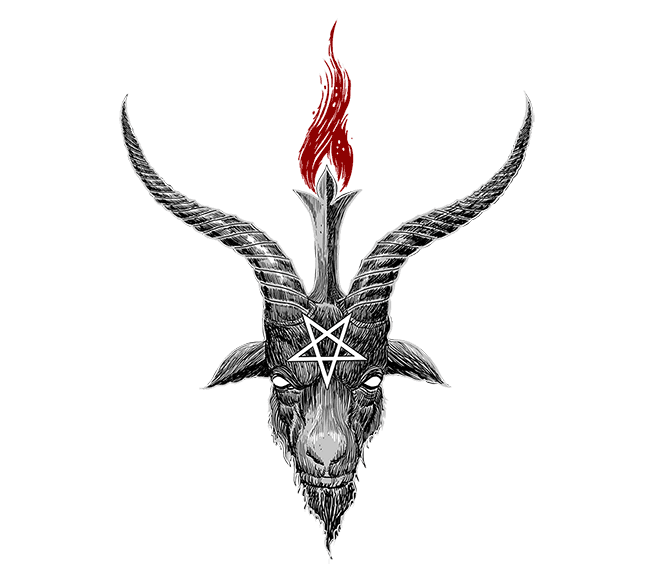
– I was born in the mid-70s, so my musical history is what one might call ‘old-school’. Everything started in the 80s when I came across the typical heavy metal titans of that time: MÖTLEY CRUE, KISS, TWISTED SISTER, ACCEPT, and so on. I then went through the successive waves of speed, thrash, and death metal – all the usual bands from Sweden, Finland, Florida, and the Bay Area. That’s also when I discovered the first wave of black metal, with acts like SODOM and VENOM.
Were you playing in bands yourself back then?
– I had some teenage projects with my friends, yes – playing mainly hardcore, punk, and thrash-like stuff. We didn’t know much about the various genre distinctions; it was mostly just a chaotic blend of everything we liked, performed as some kind of aggressive noise without any clue about how to properly handle our instruments. We were all hit pretty hard by bands like CRYPTIC SLAUGHTER, D.R.I, and WEHRMACHT. Also, RYTMIHÄIRIÖ’s debut came out around that time, as did NAPALM DEATH’s “From Enslavement to Obliteration”. We were really into Finnish and UK underground punk with hardcore influences and a straightforward anti-establishment attitude.
At some point in the early 90s, Jani began drifting into other types of music. Thrash and death metal had lost their initial appeal and he grew increasingly disillusioned.
– It became too obvious and clean. I had no idea about what was happening in Norway, nor of any ‘second wave’ of black metal. My friends who I played in bands with all started smoking pot and moving more towards 60s and 70s music – and that just wasn’t for me. So, I found a similar aggressiveness in hardcore techno, trance, and similar. I also listened to some gangsta rap in the genre’s early days; the attitude was quite interesting, but they soon became corrupted by the mainstream and lost their edge and originality. Maybe I sensed something relatable about these acts, seeing as how I myself was raised by the streets.
Perhaps it bears mentioning that, at the time, the streets of Compton and Long Island likely posed a somewhat different set of challenges than those of Hyvinkää.
– These days, I’m obviously aware that I grew up in a totally different environment, but they had a lot of hatred and so did I. I still think the likes of N.W.A, C.P.O, and early PUBLIC ENEMY had more balls than many of today’s black metal bands. Actually, thinking further about this now… perhaps some kind of resistance to the powers that be – packaged in provocative aesthetics – is as important to me as the actual music? Whoever you are and wherever you do it, it’s a good start and you have my support! Never let others deicide what you should think or do.
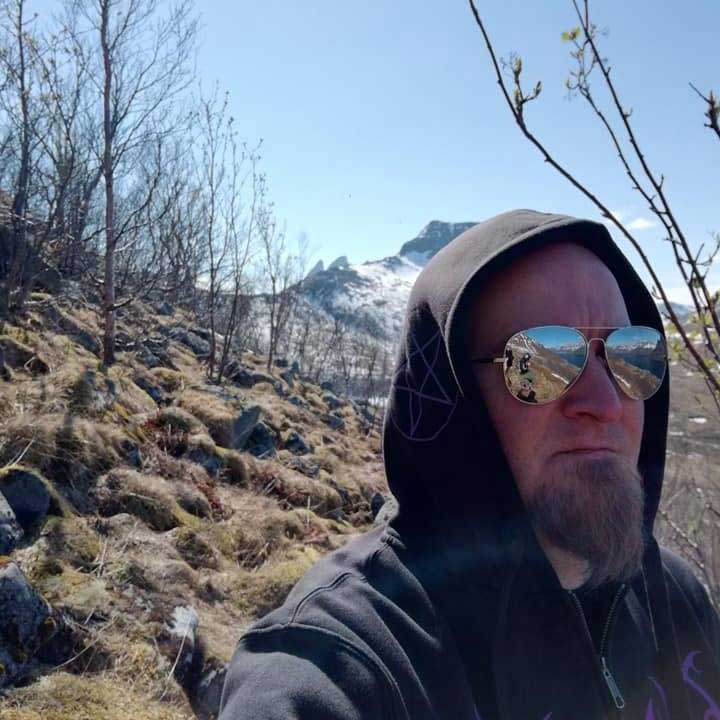
In the late 1990s, after several years spent on the peripheries of metal, Jani went back to many of his early favourites: SEPULTURA, DEICIDE, DEATH and so on.
– That’s when I discovered the purely cold era of black metal. So, while I had missed out on several years, there were now lots of great albums and acts for me to catch up on. Thanks to the emergence of the internet, it was relatively easy to find out what had been going on. All the obvious classics caught me straight away: DISSECTION, MAYHEM, EMPEROR, SATYRICON, IMMORTAL, and so on. I started exploring the scene here in Finland and then branching out worldwide to see what happened and where.
With his fervour for metal now reignited, Jani resumed playing guitar and went back to being a musician. After several years of activity, SAWHILL SACRIFICE became his first solid project, starting out as a black/thrash hybrid but gradually morphing into pure black metal.
– SAWHILL reflects my musical growth. In the beginning I was perhaps more shaped by my formative days – meaning, the 80s and very early 90s – but as time went by my song-writing started to show more black metal-influences. I learned a lot about myself and how I should henceforth execute both my music and other pursuits. For years now, I’ve been part of AZAGHAL; I also did guitars as a session member on the latest album of VARGRAV and played some gigs with them. Also, my own solo project has now released its debut album. I’m currently working on a split as well as doing session vocals for another band. But I should point out that despite having been quite active with various bands, I’ve never really considered myself a ‘musician’ per se. Nor do I call myself a ‘promoter’: just like my other projects, Steelfest is merely an outlet for my creativity.
Do you think it would’ve been possible to create something like Steelfest without your many years of underground involvement?
– Partly, yes – partly no. For all my life, I’ve been terrible at all kinds of ‘networking’. Really bad; one could even say I hate it. But after following metal for almost forty years, you unavoidably form some personal connections. However, it’s important to note that Steelfest did not start out as my own personal project – I was just part of it.
What we know today as Steelfest Open Air came from rather humble beginnings. In 2008, a handful of friends – none of whom had any experience in event management – organised a private get-together featuring live metal and alcohol in vast quantities.
– There was no need for any past experience, it was essentially just a massive party with a few local bands playing. We dragged a backline into some community centre, plugged in the instruments, and started drinking. The attendance was less than a hundred people, there were neither indications nor even ambitions for it to expand – we were perfectly content just getting drunk with our friends. Musically, I didn’t particularly care which bands were playing. Of course, this would soon come to change drastically.
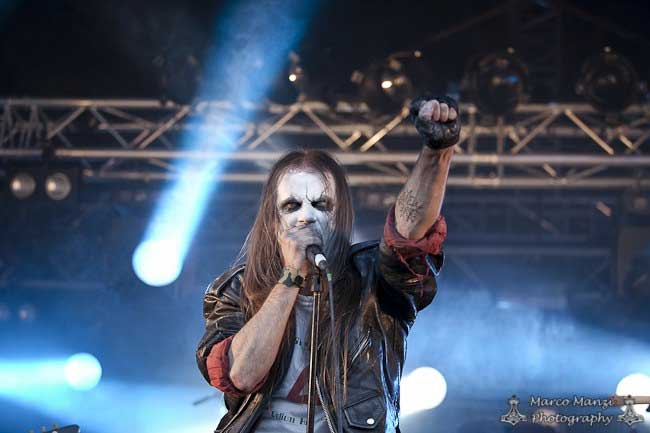
Four years later, Jani and his cohorts decided to bring what had now become their annual event to the next level. The first edition of Steelfest Open Air took place in May 2012 and featured ENTOMBED, TAAKE, THE CROWN, IMPALED NAZARENE, and many more.
– There were about six or seven of us who’d been putting on these private gatherings over the past few years. In 2012, we incorporated a company in order to make Steelfest a public event. In hindsight, this was just poor judgement from everyone involved; that is, creating a festival with a bunch of friends who each had completely different approaches to music. Nonetheless, I think we were moderately successful with the line-up. My strongest memories from the first year are feelings of ‘We did it!’ I also remember LG Petrov and the show he put on with ENTOMBED: what a friendly and easy-going guy he was. We also had plenty of vodka with Hoest – too much actually, haha!
Did it make a profit?
– No, we were nowhere near breakeven. I think we lost somewhere in the range of 45,000 euros. From day one, we made it our core value to provide the artists with as high quality of an experience as possible – and that motto follows us until this day. Which is not to say that we are always successful in this regard, but it’s a starting point. For instance, if there are decent options available, we do not fly over bands with low-cost airlines. We also adhere to tech and hospitality riders as closely as possible, we ensure that stage-management runs flawlessly, and so on. Of course, this cost a lot of money and hit us hard, especially in the early years.
The line-up of the first Steelfest was rather generic, but already with the second edition, 2013, we can see a shift more in line with the festival’s current profile. Bigger acts like SODOM, MAYHEM, DESTRUCTION, and BELPHEGOR, played alongside Finnish underground bands such as HORNA, BARATHRUM, SATANIC WARMASTER, and GOATMOON.
– Yes, our direction started becoming clear – if only partly. I had more of a voice regarding the artistic choices, but we still tried to make decisions together. Honestly, my feelings about those first years are somewhat conflicted, because there were many bookings I didn’t agree with. However, since we were a six or seven-man company, everyone had their say about which bands to feature and I believe this imbalance is reflected in our early line-ups. But in 2014, we decided to place increased focus on what we were doing; after some negotiations, four guys were bought out from the company. And that’s when I assumed total command. From 2015 and onwards, I see Steelfest as what it is today.
The 2015 edition was headlined by DARK FUNERAL – who performed “The Secrets of the Black Arts” in its entirety – NOKTURNAL MORTUM, UNLEASHED, and ASPHYX. Also participating were SATANIC WARMASTER, KAWIR, TERMNOZOR, MELECHESH, SARGEIST, and many more.
– 2016 was a harder year. POSSESSED were supposed to headline, but something happened a few months prior to the festival which meant that this was out of the question. Bands like POSSESSED take a huge part of our total budget so, once they were out, I had to re-structure almost the entire line-up. But everything came together nicely in the end: for example, we were fortunate enough to host SADISTIC INTENT, which remains one the best live death metal acts I’ve ever seen in my life. Also, there is no question that the Finnish scene was strongly represented by HORNA, IMPALED NAZARENE, GOATMOON, and the up-and-coming WHITE DEATH.
When all was said and done, the headlining performers were BLASPHEMY, 1349, GORGOROTH, and GRAVELAND. What started with turbulence ended in triumph – Steelfest Open Air 2016 was completely sold out.
– So, through tough times follows some kind of success. At this point, we’d managed to pay back some of our debts from the disaster year of 2012. Oh, and I almost forgot! As openers for the second festival day, we had BAT & RYYD – a strong act with legendary status here in Finland. They are quite different from most of Steelfest’s line-up, but this booking had a very specific purpose; there was a certain ‘pun intended’. For reasons I’ve promised not to disclose, one band had to cancel their appearance. So, when they asked who’d be replacing them, I sent them a link to BAT & RYYD: ‘These guys will be filling in for you, they have comparable levels of spirit…’, haha! Sometimes, you must do stupid things just to keep yourself entertained and make sure life remains interesting. Childish? Abso-fucking-lutely…. but still hilarious and totally worth it!
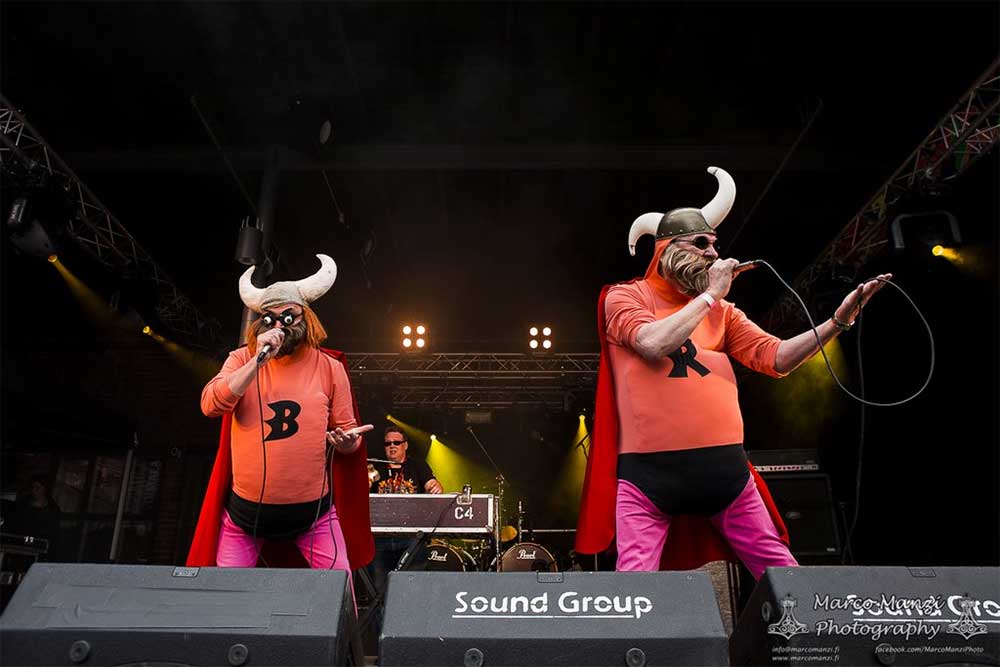
The 2017 edition of Steelfest was spearheaded by MARDUK – playing “Heaven Shall Burn… When We Are Gathered” from start to finish – alongside PESTE NOIRE and CARPATHIAN FOREST. Among the additional attractions we find BEHEXEN, SINISTER, MGŁA, ENTHRONED, LVCIFYRE, and SARGEIST. Encouraged by the success of his summer festival, Jani introduced an annual winter event in Helsinki: SteelChaos. The first edition boasted among others ARCHGOAT, CRIMSON MOON, DESTRÖYER 666, NIFELHEIM, and MASTER’S HAMMER. However, in the immediate aftermath of SteelChaos 2017, the main spotlight landed on the stage collaboration between black metal band RIDE FOR REVENGE and BIZARRE UPROAR, a Finnish power electronics project. Towards the end of the set, one performer shat on another – following which human excrement was thrown into the unsuspecting crowd.
– The performance itself was fucking oppressive and brutal! It is extremely rare to witness a show capable of creating an atmosphere like that. I will never forget it, pure evil. But the shitting part came as a total surprise to me. And if I recall correctly, several of the musicians on stage were equally surprised, haha! I must admit that I didn’t find this quite so amusing at the time, especially when I had to go find someone to clean up the faeces so our festival could continue. Of course, the media caught wind of this and became really interested, resulting in a second ‘shitstorm’. Even some of the venue staff and authorities went a little crazy over it.
Undeterred, Jani focused on growing the festival. With clear proof that his approach was working, he built further on the same concept; Steelfest 2018 was headlined by Mortiis, WATAIN, and TORMENTOR.
– This year also featured quite a few of my personal highlights: NOKTURNAL MORTUM, MOONSORROW, CULT OF FIRE, DESTRÖYER 666, SATANIC WARMASTER, ARCHGOAT, DHG, FORTERESSE, plus many others like BAICHE MA HACHE and NATTFOG. Also, that year… or was it for SteelChaos? Around this time anyway, I discovered a promising local ‘pagan’ band called HAVUKRUUNU who have since played our festivals many times. As has MOONSORROW – in fact, those two have been my favourites ‘outside’ pure black metal for a long time. Come to think of it, I’ve seen the MOONSORROW and HAVUKRUUNU guys visiting our events quite a few times even when they weren’t performing.
During my research I learned that Jani does not work during the festival, opting instead to dedicate it entirely to booze and metal.
– Correct: once the gates open, I do not work at all. If I cannot even enjoy myself on the festival weekend, then why even bother? Besides, while I’m drinking with my friends on the festival ground, I get an invaluable visitor-perspective I can use when assembling future Steelfest line-ups. What else would I like to see? What do I want my guests to see?
Have there been any disaster scenarios where you’ve been forced to intervene?
– I’m pretty sure the entire staff wants to keep me as clueless as possible, should there be any ‘disasters’ going on. My company partner takes leadership during the festival and, of course, all security, tech, hospitality, management, etcetera is handled by professionals. In the event of an emergency, they’ll be able to figure out what to do better than I ever would. We have almost the same volunteer staff and subcontractors every year; we know each other quite well by now and, if need be, everybody can take decisive action straight away. I only learn about all the incidents afterwards, at the staff after-parties, haha! But by planning ahead for all eventualities, this approach is made fully possible.
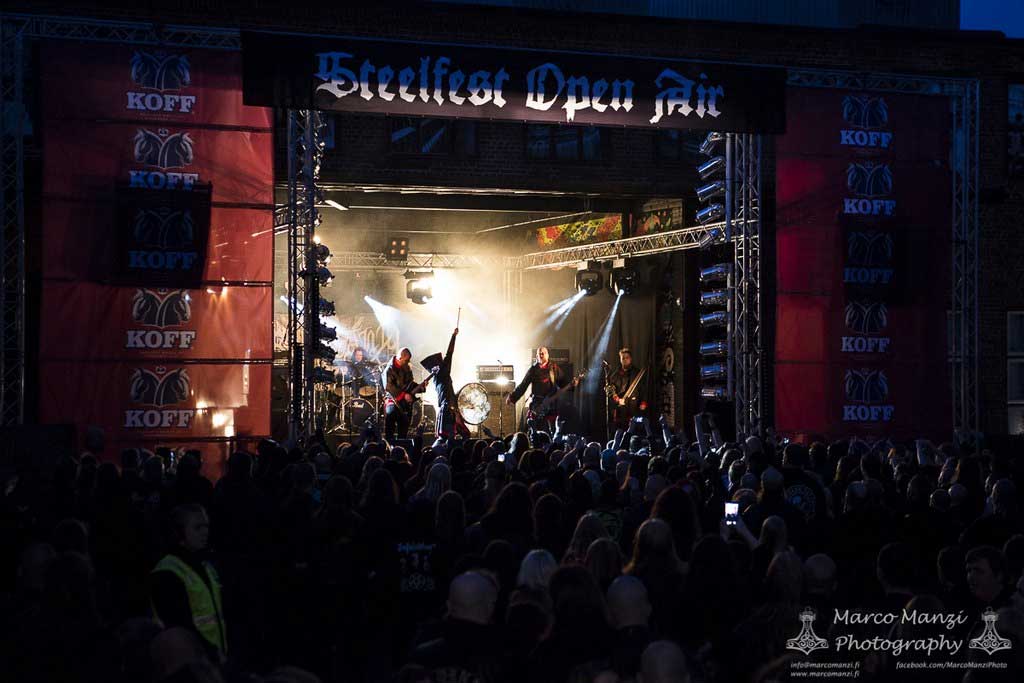
Something else Steelfest handles differently is their booking strategy. The norm with festivals is to survey social media, as well as YouTube and Spotify statistics, in order to determine which acts have the most fans who’d be willing to pay money and travel to see them.
– I know that many festival promoters follow all kinds of numbers and make their decisions based on them. But if you think about it, where will this end? Look at the line-ups of many of today’s ‘extreme metal’ festivals and the result should be obvious for all to see – we have the same safe headliner choices revolving between all the big festivals, with a few local acts added in for good measure. But this seems to work well for them so by all means keep doing it. It’s just that I myself don’t find that method especially compelling.
How do you go about looking for bands to book?
– I rarely read any webzines or album reviews but, of course, I spend plenty of time actively looking for new stuff. Every now and then, I’ll talk with friends from around the world and check whether there’s anything promising brewing in their area. ‘Dude, have you checked out this record?’ ‘No’, ‘You should.’ That’s it! This often turns up interesting acts. Actually, I just booked one US-based band after such an exchange with a friend from Chicago. Financially, it’s probably madness to fly them over to play Steelfest, but what the fuck – the band in question truly is black metal at its finest. Also, it’s important to bear in mind that many who perform at Steelfest aren’t even on social media and don’t have their music listed on Spotify or other streaming services. So, basically, I just follow my own vision.
Is Steelfest your full-time occupation now?
– Having two main fests plus some other smaller events means that I work on this daily – but it’s not what pays my bills. I don’t have a ‘normal’ day job though, all my activities are done through our company. I do a few other things on the side and this helps me get by.
Steelfest 2019 attracted in total almost six-thousand visitors from fifty-five different countries. The two main attractions were MARDUK – this time with a “Panzer Division Marduk” set – and MYSTICUM. The Scandinavians were joined by the likes of IMMOLATION, MGŁA, NARGAROTH, HORNA, and GAAHL’S WYRD. By then, Steelfest had become recognised internationally as a haven for underground metal connoisseurs.
– For me, it’s always been important that we are honest with ourselves and feel a sense of pride after each event. To not only make all this happen but also somehow prosper – unassisted by marketing machines, media partners, etcetera – without being part of the promotional campaigns of multinational corporations and a slave to the commercial values that govern them. I can see how Steelfest gathers people from around the globe, all of whom share the same resentment towards parts of the modern world; no matter of origin, religion, gender, skin colour, or personal background. Nevertheless, I wouldn’t describe Steelfest as some kind of ‘metal brotherhood’: fuck that. The true underground stays hated by the mainstream, it’s been like this forever and always will to be! Nothing wrong with that.
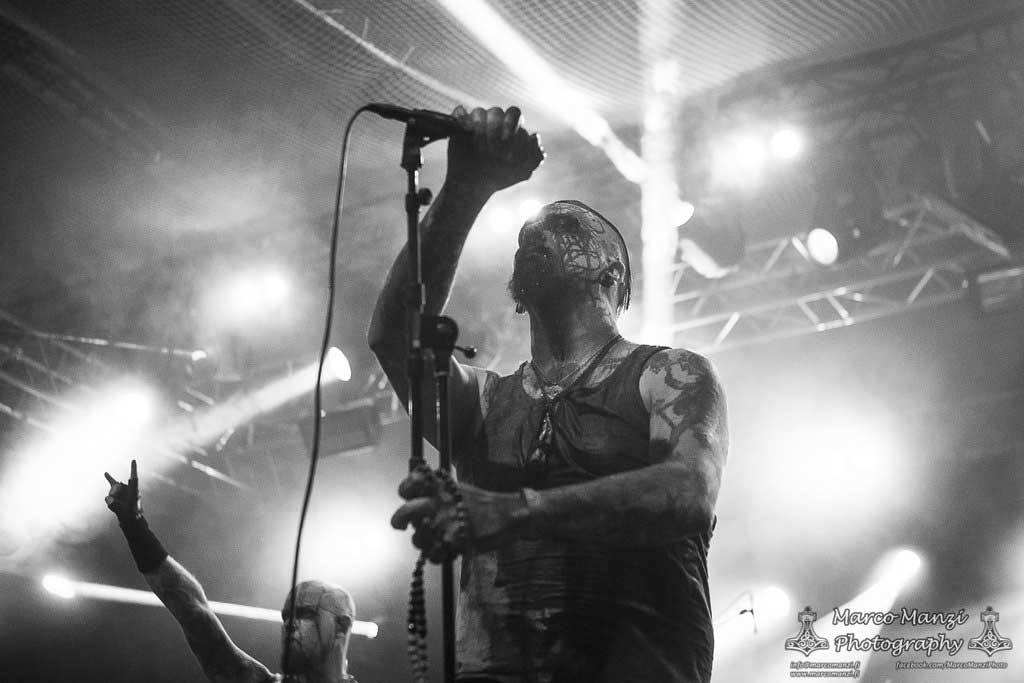
While Jani’s concept might be popular among those who attend his events, it turns out that not everyone is quite as enthusiastic. A Finnish activist group wrote no less than four full-length articles about the 2019 edition, proclaiming Steelfest a nazi festival on accounts of hosting bands like MARDUK, MGŁA, HORNA, and SEIGNEUR VOLAND. The latter, an old French black metal band, share their perspective on the matter as part of the massive print-exclusive feature in Bardo Archivology Vol. 2. The activists also published a list of Steelfest’s business partners, urging likeminded readers to take action.
– This domestic group, which is what you might call our local ‘SJW’ network, has been pestering us throughout our entire history. Those articles are downright embarrassing in terms of accuracy. They name an individual who has nothing whatsoever to do with Steelfest, nor any parts of the organisation, as owner of our company. Also, they claim to ‘know for a fact’ that we arrange festivals with supposedly ‘problematic’ record shops and labels. In reality, we’ve never collaborated with any of those mentioned: we’re busy enough with our own events. Fact or fiction means nothing to these people; they will run with whatever fits their narrative, no matter if it’s sheer fabrication.
Did anything change as a result of this?
– No, nothing. In fact, when this type of ‘pressure’ started mounting a few years ago, we initially didn’t understand what the hell they were even on about. I’m not being naïve here, honestly. I had no clue! Of course, we noticed that they were hoping to make us look ‘suspect’ by placing responsibility on us for what this or that artist has said or done in the past. Their main goal was clearly to – in one way or another – inflict as much damage to our company as possible and create problems for Steelfest’s business partners. You know, that’s how these cults work if you cross them: no interaction or attempted dialogue, just terrorising. Your only means of escape is to cave in and obey. Cancel your performance, issue statements in support of their agenda, and deny your own history. Should a member of your band be deemed questionable, he must be kicked out immediately.
Did you take any counter-measures?
– Well, we spoke with the police – ‘What the hell is going on? Is it even legal to spread disinformation about other people like this?’ After a short investigation by law enforcement, they explained that this is an insignificant but extremely active group who employ such tactics to draw attention to themselves, and in doing so promoting their political ideology. The cops said that we were well within our rights to press charges for defamation, ‘but all that would accomplish is bringing them closer to their goal’. Ever since, we’ve simply ignored the efforts of this irrelevant little group.
They also called for people to contact the city of Hyvinkää and demand that local authorities shut Steelfest down. This does not appear to have had much of an effect either.
– Hyvinkää is small city. Everyone here knows us, our events, and the whole organisation from top to bottom. Many public officers and members of the local council even visit Steelfest in person, so they have seen with their own eyes that this festival is nothing like what these totalitarian cults paint us out to be. But let us acknowledge one thing here: such methods aren’t even remotely rooted in a wish for a civilised society. What once started from the ‘left side’ of politics isn’t promoting social democratic views anymore, if it ever did. Quite the opposite. Threats, blackmail, sabotage, social media harassment – all the shit they pull is reaching proportions of religious persecution. And on that note, there is something I want to say about this. I’m sure you’ve noticed the increasing polarisation; how one is forced to pick a side. Bipartisan interaction is no longer possible, right?
You are implying that this was not an entirely organic development?
– Well, over the last decade we’ve witnessed the biggest transfer of wealth in recorded history. I don’t know, but one might think that something like this would warrant the slightest bit of concern from those who identify as being on the left side of the political spectrum. Instead, it seems to me as if the left has mutated and been subverted into its current incarnation – with their psychotic fixation on gender, race, intersectionality, or whatever the current buzzwords are. So, if the undivided attention of the left side is on these matters, rather than the biggest transfer of wealth in recorded history, then we must conclude that polarisation works. And then consider this: who is the winner when people are divided and fighting amongst themselves? Divide, conquer, and control both sides.
Divide et impera, or divide and rule policy, is a strategy employed both in wartime and politics against foes greater in numbers. Historical examples range everywhere from the Romans to Napoleon. In colonialism, it’s often been a useful ploy to quench rebellion in the native populace. Stirring up distrust and enmity between large domestic groups fosters division which, in turn, prevents the formation of alliances among those who could collectively challenge the ruling order.
– This is not about ‘NSBM’, nor is it about the left or right side of the political spectrum – that much should be blatantly obvious. And it’s working perfectly. The mindset of the left seems to be that banning someone or disapproving of their content, de-platforming or cancelling, will have the desired result: getting them to start ‘behaving’. This is because these people are under the illusion that everyone else is as they are. But such repression gives the ‘target’ a sense of self-righteousness and motivation to fight back. The ‘left-side’ doesn’t seem to understand this, so they push even harder. Of course, their counterpart isn’t much better. The ‘right’ has taken an underdog position and seems to think that all their beliefs are under assault, they imagine that anyone and everyone can be against them. So, once again society becomes more divided, further escalating conflict.
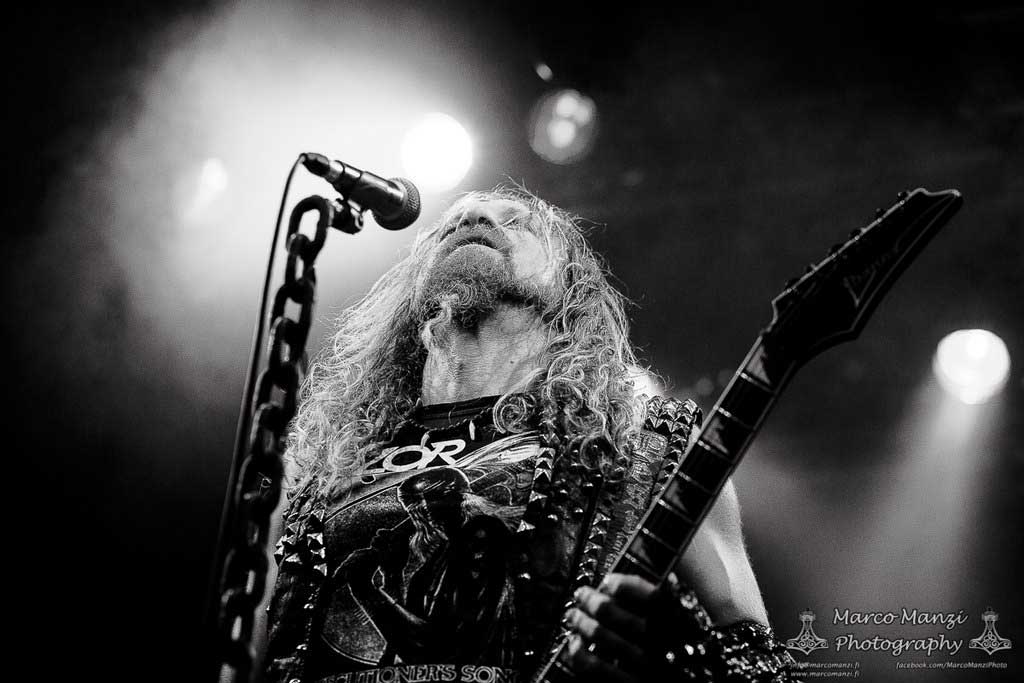
I’d wager that March 12, 2020, was one of the most miserable days of Jani’s earthly existence. With two months to go, Steelfest – along with the rest of Finland – were notified that any kind of gathering with an expected attendance of over five hundred would not be permitted to go ahead.
– When the government made this announcement, I was in a meeting with city representatives. We turned on the TV and watched the press conference… for a moment there, it felt as if my guts were about to spill to the floor. But it didn’t come as a total surprise; in the weeks leading up to this there were plenty of signs about what might happen in a worst-case scenario.
Later that same day, Jani had somehow composed himself enough to communicate the bad news through the festival’s social media. His statement is calm, collected, and informative – unemotionally written, but one can almost sense the underlying despair.
– Thinking back now, I don’t recall all that many emotions. Frustration? Plenty, but there wasn’t much to be done; everything was out of my hands. I spent several days watching the developments closely, trying to keep everybody informed about what was going on and what our plans were. Once the pandemic reached Europe, I didn’t think it was gonna stop – and sure enough, it didn’t. Mentally, I had prepared for major problems. So, when it started, I was pretty focused and knew precisely what to do. But it was March already: all the efforts had been made and most of the budget spent.
Were you hit hard by this?
– Let’s just say that we will be paying off the losses from all this for a long time to come. By 2019, we’d finally managed to settle our last debts from the early days. Steelfest 2020 was supposed to be the first edition where we actually made some money. Instead, two years passed without events and here we are.
Jani made another post two days later, March 14, assessing his past forty-eight hours. He acknowledged the massive outpouring of support from both bands and attendees – many of whom wanted to know how they could help.
– I was aware that we might have earned some trust, but the immense show of support was very moving to behold. As you mentioned, we got feedback asking us to set up a crowdfunding campaign or similar. Personally, I have problems when bands – or anyone else for that matter – asks for money without offering anything in return. Or, at its worst, they give you a PC desktop wallpaper for twenty bucks. Argh! Just thinking about this raises my blood pressure and makes me puke. So, accepting charity was out of the question. Instead, we ended up with this Steelfest Hordes ‘support pack’ which included buttons and stickers as a small token of our gratitude. I calculated that the proceeds from this covered approximately eight percent of the losses we incurred in 2020.
The spring of 2021 saw another one of those unpleasant announcements: the additional one-year postponement of what was initially Steelfest 2020. This announcement was made about a month before the fest was meant to take place; I can only assume it came as less of a surprise than the first one.
– We had booked flights and paid advances for some bands already in 2020, so in 2021 we tried to avoid as many additional expenses as possible. But of course, until the government rules otherwise, our job is to organise events and that costs money. So yes, we were one hundred percent ready to go. Our line-up was almost fully complete from 2020; all the bands just postponed their performance by one year. However, considering the state of things in springtime, we didn’t have high expectations. Pandemic control was a total mess, especially for events and festivals, and we bore the brunt of all this.
May 14, 2021 – what was meant to be the first day of Steelfest 2021 brought with it good tidings. For its tenth anniversary, the festival was to be extended by two additional days. A hell of a comeback.
– I just thought, ‘I want to celebrate this in style.’ I decided to bring back all the bands who helped us get to where we are today: NOKTURNAL MORTUM, PRIMORDIAL, INQUISITION, SATANIC WARMASTER, MOONSORROW, HORNA, ARCHGOAT, and so on. Then I went… ‘You know, what the hell – let’s invite the entire top tier of the Finnish scene! And then mix it up with our personal favourites from around the world.’ Our hopes were that followers of Steelfest would find it worthy enough to travel here and celebrate the anniversary with us. So, it was undoubtedly the case of going ‘all in’.
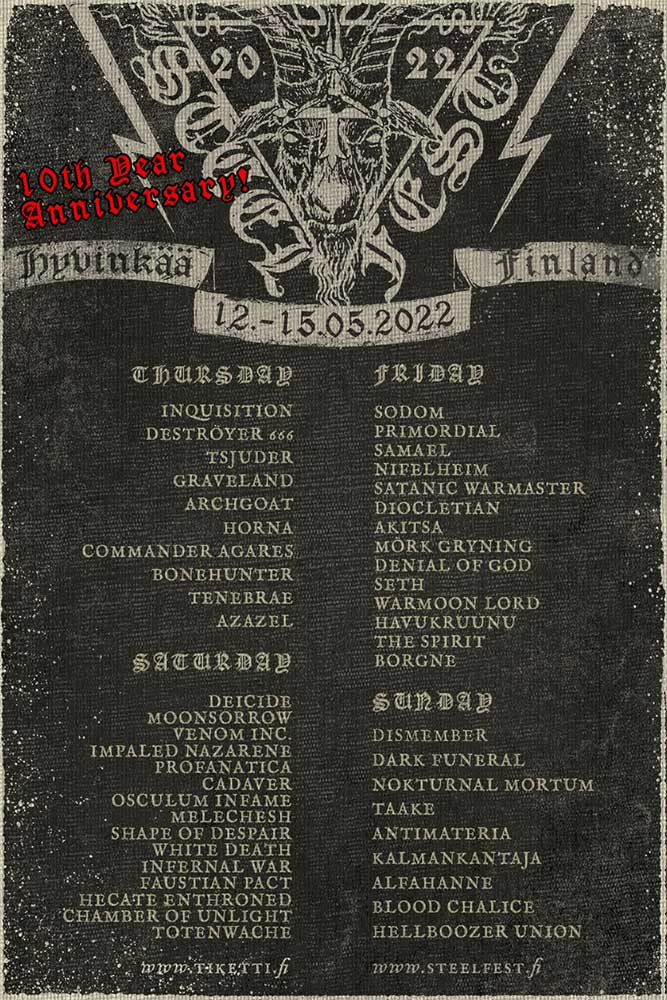
You have reached the end of the first part of this conversation. The second, which focuses entirely on Steelfest 2022, will be published next week.



